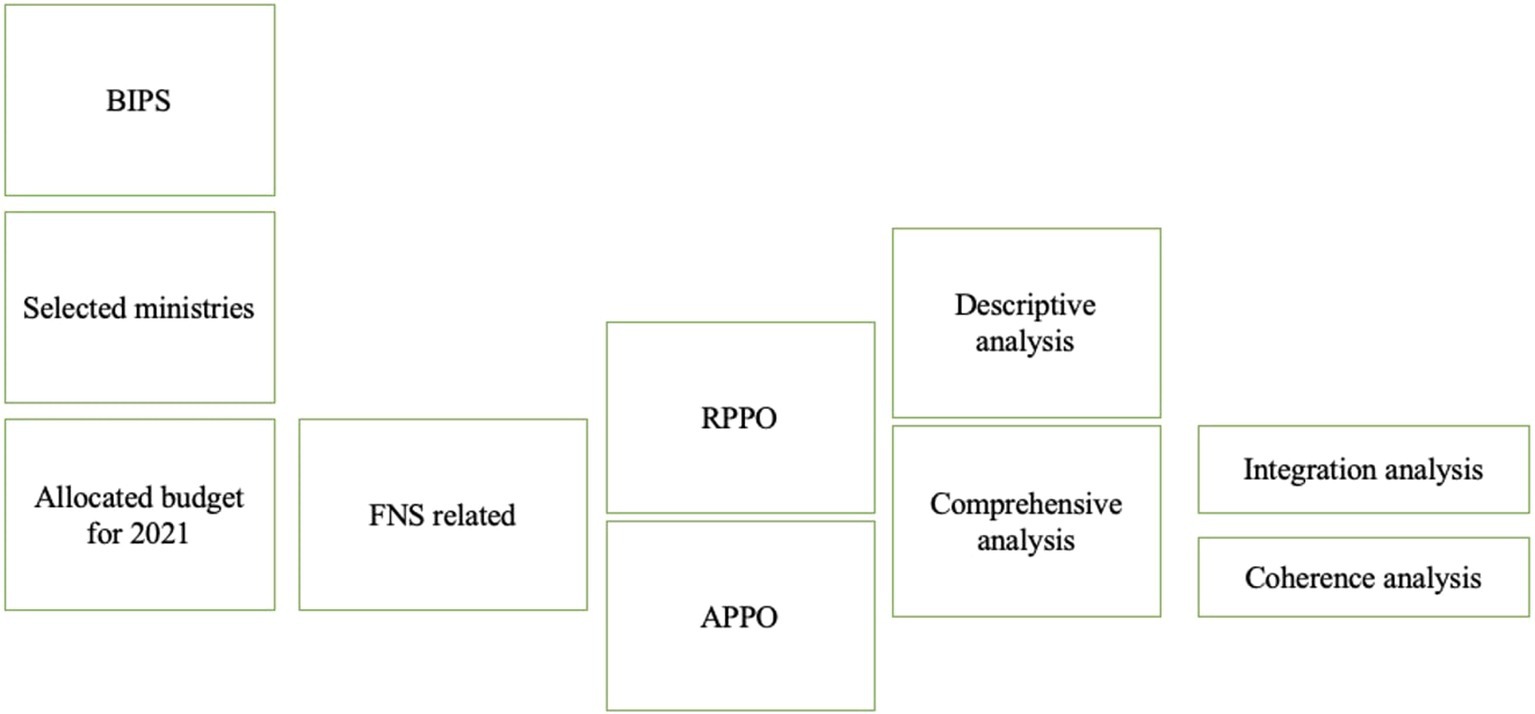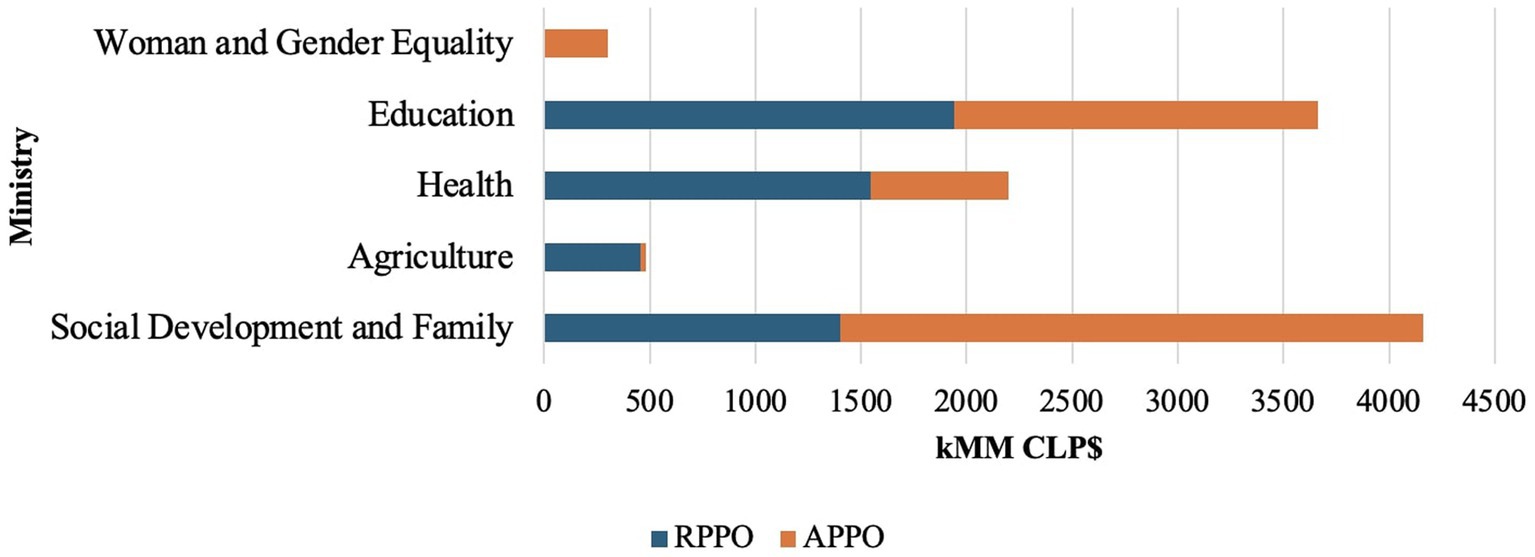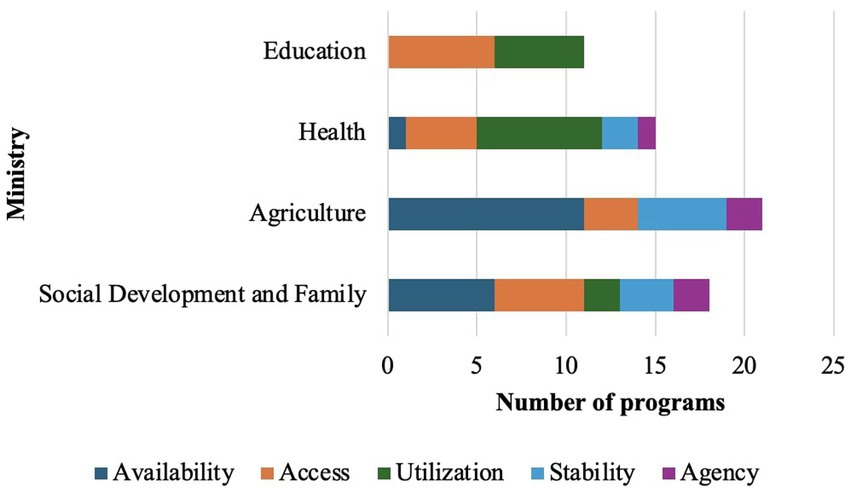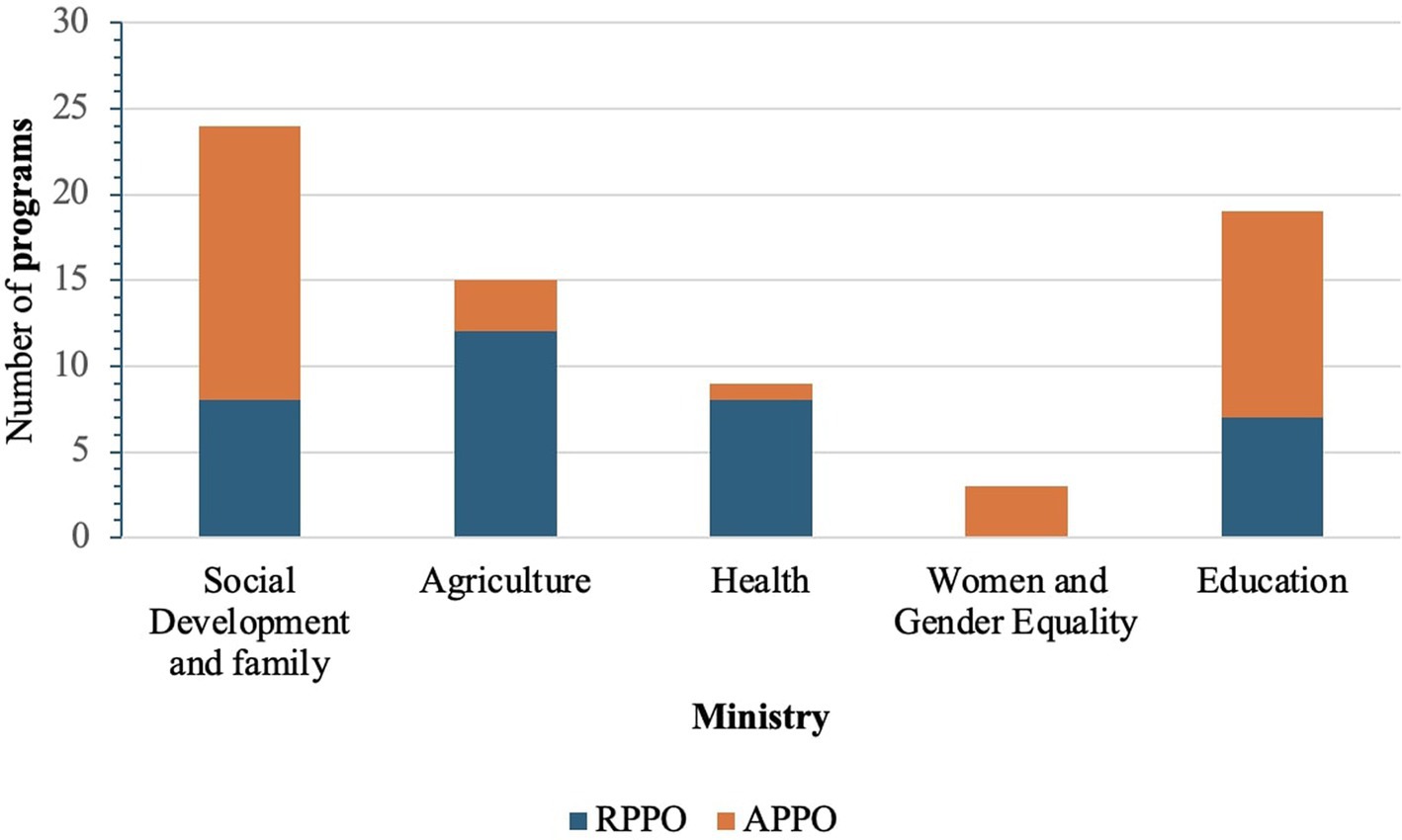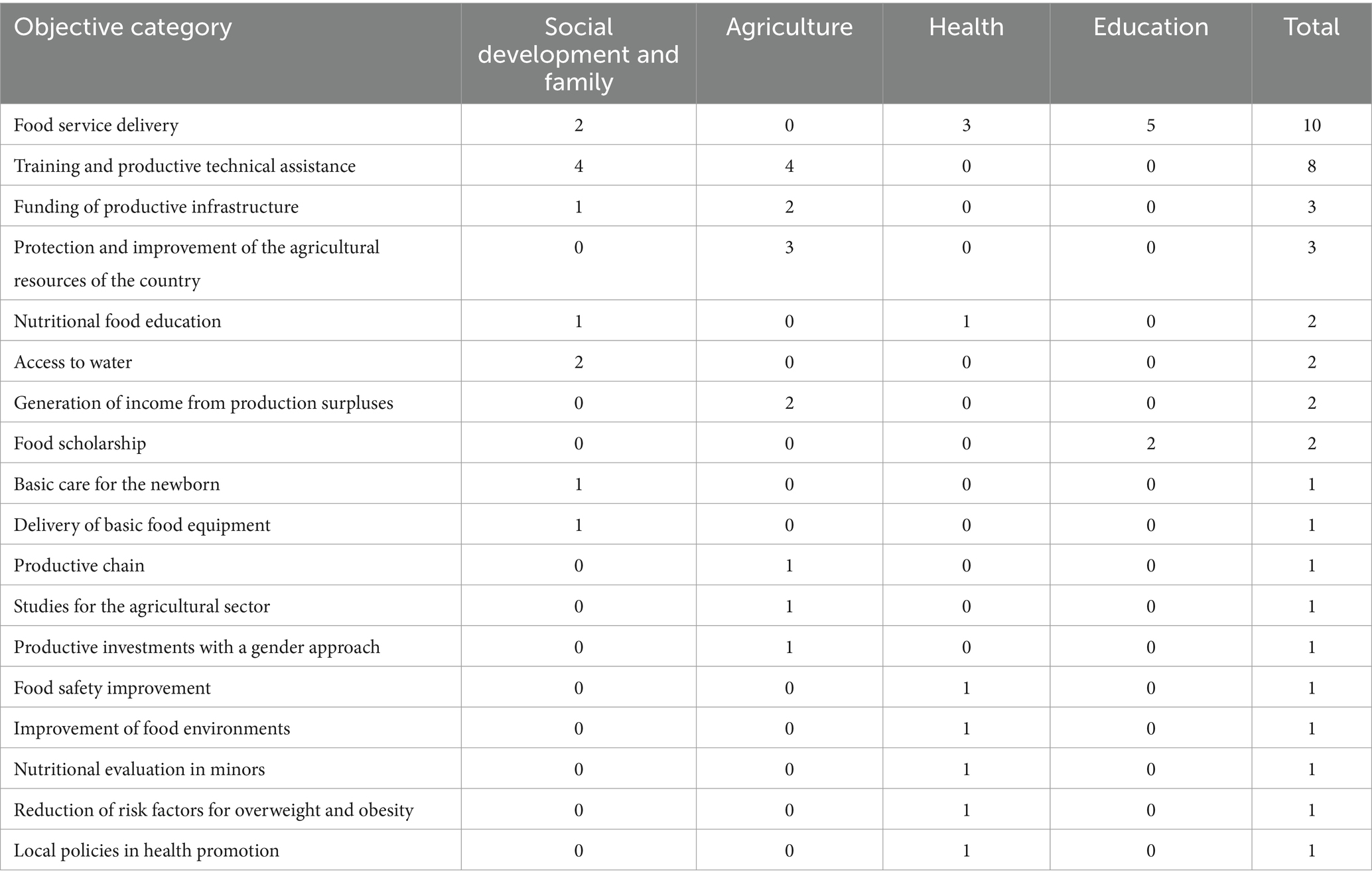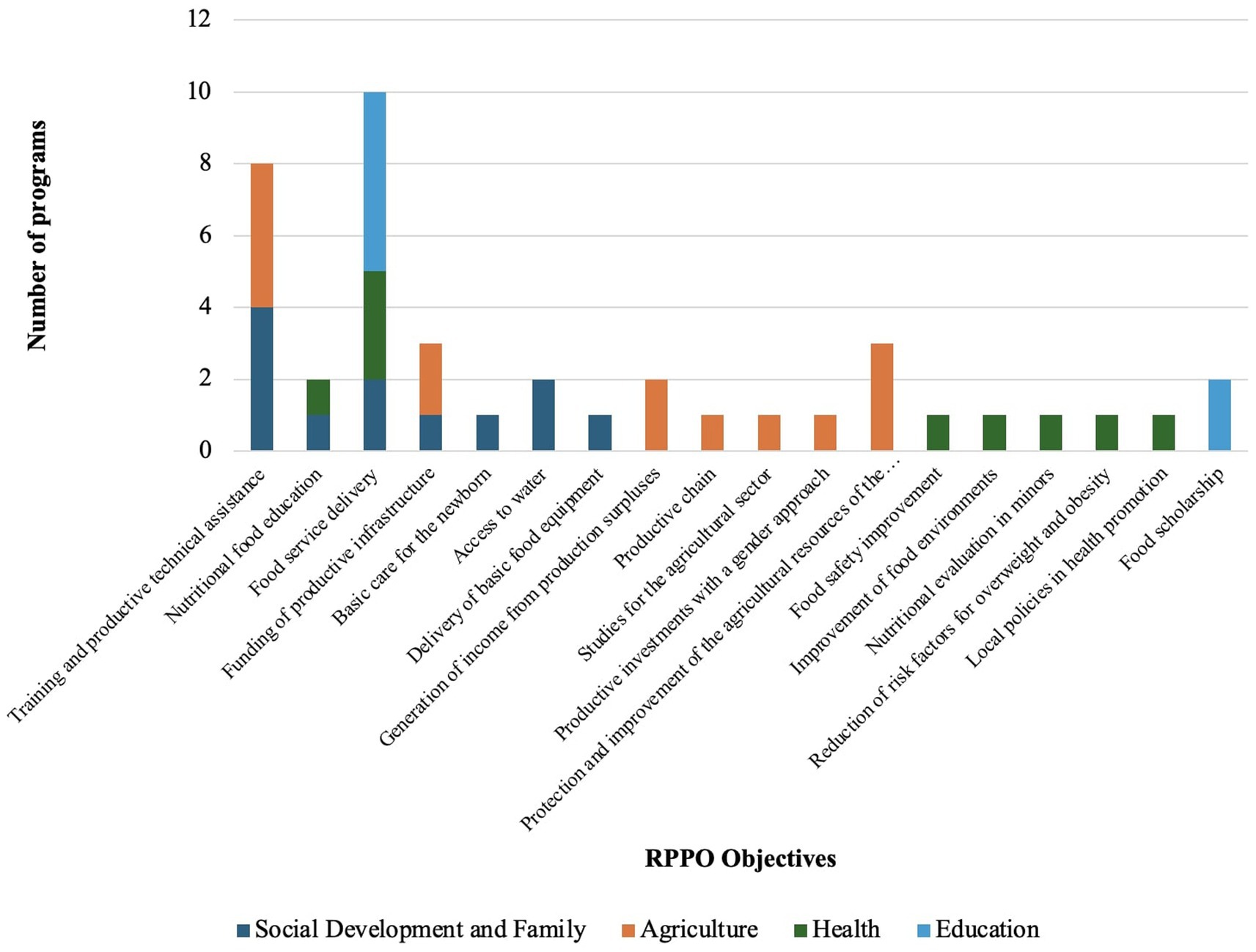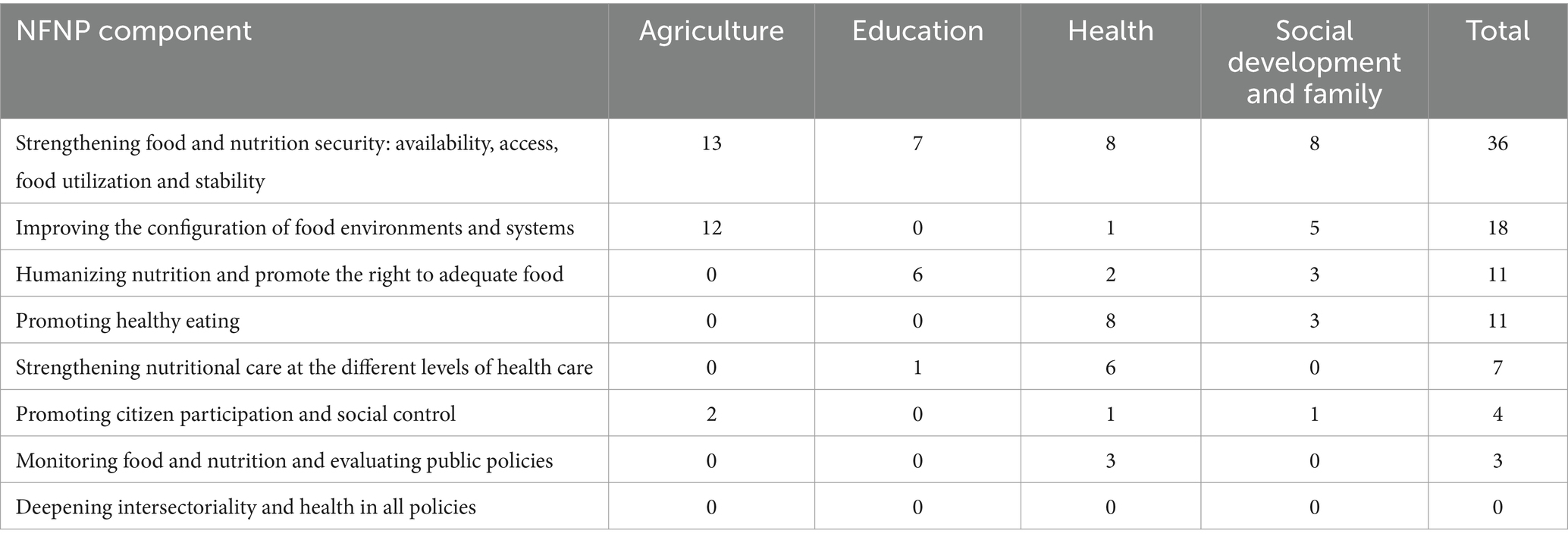- 1Global Academy of Agriculture and Food Systems, University of Edinburgh, Edinburgh, United Kingdom
- 2Department Management and Rural Innovation, Faculty of Agricultural Sciences, University of Chile, Santiago, Chile
This study critically examines Chilean food governance. In particular it focuses on two aspects of inter-ministerial governance: policy “integration” and policy “coherence.” It does so by evaluating the alignment between two key policy objectives within the Chilean government; the Social Determinants of Health (SDH) and National Food and Nutrition Policy (NFNP) objectives. This is accomplished by using publicly available data at the Integrated Bank of Social Programs (BIPS – Banco Integrado de Programas Sociales) collected in 2021. Utilizing mixed methods including content analysis, program review, and financial analysis, 245 public programs were scrutinized. Only 0.042% of the 2021 national budget for public programs was allocated to n = 70 key programs directly addressing food and nutrition security (FNS), highlighting significant resource disparities among ministries. While some inter-ministerial integration was observed, overall coherence with NFNP objectives, particularly in “health integration and intersectorality,” was lacking. Since disparities in resource allocation and neglect of stability and agency within food security across ministries are identified, indicating a variegated approach to food security with differing emphases on availability, utilization, and access, this study calls for a collaborative, multi-sectoral strategy to bridge policy gaps and enhance coherence in addressing food security challenges. Its findings contribute to the discourse on food governance, offering insights into policy implementation gaps and suggesting avenues for enhancing inter-ministerial integration and coherence. This research underscores the importance of a comprehensive approach to policy formulation and execution in achieving NFNP goals and addressing the complex challenges of food security in Chile.
1 Introduction
Despite global advances in agricultural science and technology development, hunger and malnutrition continue to affect millions of people around the world. Fragmented policy responses and lack of coordination have often exacerbated these issues, as seen in various international contexts (Kushitor et al., 2022). This highlights the need for inclusive multi-stakeholder processes to effectively address such challenges (Duncan and Claeys, 2018). It is estimated that between 720 and 811 million people faced hunger in 2020, 118 million more than in 2019, while one in three people did not have access to adequate food during the same period (FAO, UNICEF, WFP, WHO, 2020). In 2016, 1.9 billion adults were overweight, 650 million of these obese, and 39 million children under the age of 5 were overweight or obese in 2020 (WHO, 2021), with diet-related non-communicable diseases rising sharply (Hawkes and Popkin, 2015; Hawkes et al., 2020) In addition, the number of people suffering from “hidden hunger” (insufficient intake of essential minerals and vitamins required in small amounts by the body for proper growth and development) was likely to be between 1 and 2 billion in 2021 (WHO, 2021).
The case of Chile reveals the dual challenge of undernutrition and overnutrition, since the country experienced a classic post-nutritional transition stage by nearly eradicating malnutrition in the late 1980s and subsequently witnessing an increase in its rates of overnutrition (Vio del Río, 2007). Over the course of almost 40 years, this shift has led to an alarming statistic: an estimated 74.2% of the Chilean population is now classified as overweight (National Health Survey, 2017). Furthermore, the period between 2005 and 2017 saw a 66.3% increase in child obesity rates (EVS-Elige Vivir Sano, 2020). This reality has meant that three million Chileans are now dealing with non-communicable diseases (NCDs) linked to obesity, impacting their overall well-being, productivity, and straining the national healthcare system (Fernández et al., 2017). On the other hand, according to the last National Socioeconomic Characterization Survey (2022), around 16.3% of households in Chile faced moderate food insecurity, while 3.5% suffered from severe food insecurity, primarily due to financial limitations. This juxtaposition of overconsumption of unhealthy foods and food insecurity has led to what is often termed the “double burden of malnutrition” (Shrimpton and Rokx, 2012).
In response to these complex challenges, the Chilean government introduced in 2017 the “National Policy of Food and Nutrition” (NFNP) (National Food and Nutrition Policy, 2017). The vision of the NFNP is to contribute to improving the health status and quality of life of the national population through the development of regulations, strategies, plans, programs, and projects in the field of food and nutrition. This comprehensive policy comprises six approaches and eight components designed to address the multifaceted dimensions of nutrition and health disparities. These approaches and components, found in Supplementary Table 1, range from promoting healthy eating and improving food environments to enhancing nutritional care and citizen participation. One of the approaches are the “Social Determinants of Health” (SDH), defined by the World Health Organization (WHO) as “the conditions in which people live, encompassing factors such as local governance, public policies, housing and land, culture and social values, social class, gender, and ethnicity, all of which collectively shape their health status” (WHO, 2013). Chile is no exception to this pattern, as in the context of both undernutrition and overweight, being a woman, residing in rural areas, and having less than 8 years of formal education exemplify social determinants of health that negatively impact food and nutrition insecurity in the country (National Health Survey, 2017; National Socioeconomic Characterization Survey, 2022).
The incorporation of the SDH within the NFNP reflects an understanding of the factors influencing health outcomes. By recognizing the impact of socio-economic status, gender, and education on nutritional well-being, the policy acknowledges that addressing health disparities requires a holistic approach that goes beyond dietary recommendations. This integration of social determinants underscores the commitment of the policy to tackling the root causes of both food insecurity and malnutrition. Thus, to better address both global and Chilean food challenges, it is necessary to understand the broader mechanisms and structures that influence food and nutrition security. In this regard, the concept of “food governance” emerges as a pivotal framework for analysis and intervention.
Food governance is a comprehensive concept that encompasses the formal and informal rules, interactions, institutions, and mechanisms governing decisions and actions related to food and nutrition security at local, national, and global levels (Candel, 2014; del Valle M et al., 2022). It involves the exercise and balance of power within specific institutional contexts, which are designed to direct, control, and regulate activities related to food security, emphasizing the need for these institutions to be perceived as legitimate, accountable, and transparent (Candel, 2014). Furthermore, the scope of food governance extends to shaping the entire food system, influencing actors, processes, and outcomes in the production, distribution, and consumption of food, fostering sustainability in health, heritage, and natural environments (Moragues-Faus et al., 2017). Moreover, the significance of food governance becomes even more evident when considering its complex interconnection with climate change, an area in which the food and agricultural sector not only contributes significantly but is also highly vulnerable to adverse effects, as noted by Clapp et al. (2022). Within this framework, food governance plays a crucial role in both the genesis and mitigation of food insecurity. Suboptimal governance, present within conflicts, institutional deficiencies, inadequate policy design, and delays in implementation, can significantly hinder the production and equitable distribution of healthy foods. In contrast, effective governance is essential to ensure the sustainability, resilience, and equity of food systems, thereby guaranteeing universal access to safe, nutritious, and culturally appropriate food (Candel, 2014). In this sense, that effectiveness can be achieved when certain characteristics, including policy integration and coherence, are found to play a crucial role in shaping effective and resilient food systems necessary for fostering food security.
Integration in food governance is defined as the coordination of policies, actions, and stakeholders to address interconnected challenges in the food system (Sibbing et al., 2021). It involves recognizing the interdependence of various food system aspects, necessitating coordinated governance to mitigate duplications and contradictions, thereby enhancing the overall efficacy of related governance objectives. By leveraging different agricultural policy levers, it is possible to promote healthier diets and address the growing prevalence of obesity and diet-related chronic diseases. For instance, crop diversification and targeted subsidies can enhance the availability and affordability of nutritious foods, aligning agricultural production with public health goals (Hawkes, 2007). Candel and Biesbroek (2016) also acknowledge the complexity of food security challenges, suggesting that horizontal, vertical, and stakeholder integration are key elements that enhance policy implementation, reduce fragmentation, and foster stakeholder participation and ownership, thus improving the effectiveness of food governance. Moreover, Candel (2019) indicates the importance of addressing externalities and trade-offs through institutional alignment at the policy domain level, which promotes consistency and collaboration. Similarly, Chinseu et al. (2018) emphasize the need for integration to embed social, economic, and environmental objectives into national policy, ensuring coordination, and mutual support among policies, leading to better resource use efficiency, improved food security and nutrition outcomes, and increased resilience of food systems, all while addressing the diverse needs and perspectives of stakeholders.
Coherence in food governance refers to the coordinated alignment of policies across sectors and ministries to support food security goals, ensuring they complement rather than undermine each other (Brooks, 2014; Thow et al., 2018). It involves promoting mutually reinforcing policies while avoiding negative spillovers, aiming for a harmonious balance between health, environmental, social, and economic objectives within the food system (Monticone et al., 2023). This concept involves ensuring that at a national level, policies across sectors and ministries work in a coordinated manner, supporting one another to optimize the collective impact, thereby enhancing policy effectiveness and resource allocation efficiency while minimizing waste and preventing unintended negative consequences (Brooks, 2014; Monticone et al., 2023). Thow et al. (2018) also advocate for the importance of fostering synergistic relationships and averting adverse effects among different policy areas. From a broader view, coherence aims for policy alignment within the entire food system to find a balance among health, environmental, social, and economic objectives, thus avoiding undermining efforts in one area while enhancing another (Monticone et al., 2023). The adoption of a coherent approach in food governance is instrumental in mitigating policy conflicts and trade-offs, leading to more equitable and efficient outcomes that address the multifaceted challenges of food governance. This approach enhances sustainability through the promotion of positive policy synergies and by cultivating trust and cooperation among stakeholders—key elements for food security (Brooks, 2014). Coherence also improves nutrition outcomes and supports the pursuit of health, environmental, and socio-economic objectives, ensuring that policies are not just efficient but also effective over the long term (Thow et al., 2018). Furthermore, a coherent approach fosters transparency and accountability, aiding stakeholders in understanding how policies align with broader goals and thereby strengthening the legitimacy and effectiveness of food systems governance (Monticone et al., 2023).
In this sense, public programs are crucial for informing food governance policies by providing essential resources, facilitating inclusive decision-making, and promoting stakeholder participation. Candel (2014) and Moragues-Faus et al. (2017) highlight their roles in offering financial support and crucial data for evidence-based policy decisions on food security and sustainability. The effectiveness of these programs, however, is influenced by political contexts, engagement levels, and resource availability as noted by Candel and Biesbroek (2016). Thow et al. (2018) stress the need for increased civil society involvement to enhance policy coherence. Additionally, public programs contribute to policy-making by delivering research and analysis, engaging stakeholders in identifying priorities, and promoting cross-sector learning, crucial for cohesive governance as discussed by Chinseu et al. (2018).
Considering what has been described around the Chilean food security challenges, effective governance through policy integration and coherence, and the role of public programs as policy informers, this study aims to highlight the significance of policy “integration and coherence” to meeting food security objectives. It does so through a case-study on Chilean food governance, in particular by “assessing the integration and coherence of Chilean ministerial food governance related to the Social Determinants of Health (SDH) with the Chilean National Food and Nutrition Policy (NFPN).”
2 Methods
To address the aim of this study, a four-step methodology was followed, including (1) Program Objective Review and Financial Analysis; (2) Content Analysis of Food Security Integration; (3) Thematic Analysis of Inter-Ministerial Integration; and (4) Content Analysis of Alignment with National Policy. Figure 1 shows the research flow followed.
2.1 Program objective review and financial analysis
A detailed review of program objectives was conducted to discern the presence of Food and Nutrition Security (FNS) dimensions. Following the framework by DIPRES [Dirección de Presupuesto de la República de Chile] (2021), programs were categorized into Relevant Public Programmatic Offer (RPPO) and Associated Public Programmatic Offer (APPO). The RPPO was defined previously by these authors as the “set of programs executed by organizations and agencies that play a leading role, since they have clear and explicit legal mandates, an institutional mission, a functional structure at their service, strategic products, as well as the participation of the program and operating budgets provided.” On the other hand, the APPO refers to those “actions that have an indirect impact or implicit objectives to the Chilean food security purpose, such as money transfers, scholarships, microcredits, financial education, conservation of ecosystems, entrepreneurship, and labor insertion” (DIPRES – Dirección de Presupuestos de Chile, 2021). For both groups, it was established as an initial selection criterion for further analysis that: (1) programs should have had an allocated budget for the 2021 period; (2) reference to at least one of food security dimensions provided by FAO (1996) and Chappell (2018) - availability: (physical presence of food, which is determined by the quantity of food produced and imported into a country, as well as the efficiency of the food distribution system); access (refers to the ability of individuals to obtain food and depends on economic and physical means, which include income, prices, and purchasing power, as well as the physical distance to food sources; utilization: (refers to the proper use of food, which encompasses the nutritional value and safety of the food consumed, including also factors such as food preparation, dietary practices, and overall health, which affect the ability of the body to absorb and use nutrients); stability (refers to the consistency of the availability, access, and utilization of food over time and emphasizing the need to prevent fluctuations that could jeopardize food security, such as seasonal shortages or economic shocks; and agency (refers to the requirement that citizens are empowered in defining and securing their own food security, and thus that there are competent sociopolitical systems wherein policies and practices may be brought forth by the will of the citizens and reflected in governance to enable the achievement of overall food security) described in their objectives.
Information was organized using a Microsoft Excel spreadsheet in which each social program had associated content related to their objectives, their budget, the ministry to which they belong and the food security reference(s) in their objectives. The software “ATLAS.ti” was utilized to systematically organize the objectives of each program and to categorize them according to the various dimensions of food security, thereby facilitating comprehensive analysis and coding of program objectives. With the aim of identifying patterns in food security emphasis, the number and distribution of programs across the selected ministries were quantified and a further financial analysis entailed the calculation of the total budget for 2021, juxtaposed with the national budget to contextualize the proportion dedicated to food security. Programs details, including objectives and budget was obtained at the Integrated Bank of Social Programs (BIPS – Banco Integrado de Programas Sociales, 2021).
2.2 Content analysis of food security integration
A systematic content analysis was conducted to explore how ministries integrate food security dimensions—“availability,” “utilization,” “access,” “stability,” and “agency”—into their RPPOs. This involved scrutinizing program documentation and classifying each program according to the relevant food security dimensions. A matrix was devised to map programs against these dimensions, facilitating a list of programs that addressed each one, thereby ascertaining the focal points of the efforts of each ministry.
2.3 Thematic analysis of inter-ministerial integration
The third phase of the study undertook a thematic analysis to evaluate the inter-ministerial integration of food security within RPPO objectives. RPPO objectives were extracted, categorized into 18 distinct categories, and coded to assess the thematic concentration of objectives across ministries. This process highlighted the distribution of focus areas and the extent of multi-sectoral objectives, suggesting the level of collaboration or overlap among ministerial responsibilities.
2.4 Content analysis of alignment with national policy
Finally, the alignment of RPPO objectives with the NPFN was evaluated. Through content analysis, each RPPO was assessed for its adherence to the NPFN components, creating a co-occurrence table for quantification. By using Atlas.ti, this table was later visualized through a Sankey diagram with particular attention to identifying and documenting gaps in RPPO objectives that lacked correspondence with any NPFN component.
3 Results
3.1 Program objective review and financial analysis
3.1.1 Food security related programs: RPPO vs. APPO
A total of n = 245 public programs were retrieved from the selected ministries of Agriculture, Health, Social Development and Family, Women and Gender Equality, and Education. Of them, n = 229 were found to have an associated budget for the 2021 period. When analyzing the existence of FNS dimensions references in their objectives, we found that a total of n = 70 programs, of which n = 35 belonged to the RPPO and n = 35 to the APPO. The total budget allocated for 2021 was kMM CLP $10,804.5 (average conversion rate for 2021 was $759.27 CLP/USD, Banco Central de Chile, 2021), being kMM CLP $5,342.41 (kMM equivalent to one billion Chilean pesos) from RPPO, and kMM CLP $5,462.04 from APPO. If it is considered that for 2021a total of kMM CLP $26,044,875 was directed to public programs, the budget allocated for both RPPO and APPO represents a 0.042% of the national budget. Budget details for RPPO and APPO across selected Chilean Ministries can be found in Supplementary Tables 2, 3.
3.1.2 RPPO and APPO distribution across the selected Chilean ministries
The Ministry of Social Development and Family (n = 24) and the Ministry of Education (n = 18) are those with the largest number of programs as a whole. The Ministry of Agriculture presented the largest number of RPPO (n = 12), and Social Development and Family the largest number of APPO (n = 16). No RPPO at the Ministry of Women and Gender Equality. More details can be found in Figure 2.
3.1.3 RPPO and APPO budget across the selected ministries
In terms of the total budget allocated per ministry (Figure 3), Social Development and Family (kMM CLP $4,160; 38.5%) and Education (kMM CLP $ 3,661.74; 33.9%) concentrated most of the resources. From the RPPO side, Education (kMM CLP $1,941.93; 36.3%) had the majority of the resources and Agriculture (kMM CLP $454.98; 8.5%) the fewest. From the APPO side, Social Development and Family (kMM CLP $2,759.82; 50.5%) had most of the budget, whereas Agriculture the lowest (kMM CLP $25.63; 0.5%). Finally, Woman and Gender Equality only got budget for APPO (kMM CLP $301.78).
3.2 Content analysis of food security integration
Food security dimensions and priorities are emphasized differently in the RPPO of selected Chilean ministries. For example, when it comes to the Ministry of Agriculture, they put more focus on the “availability” of food, with n = 11 programs. The Ministry of Health tends to focus on how food is “utilized” or used for health, having n = 7 programs in their offer. Meanwhile, the Ministry of Social Development and Family seems to care most about both “access” to food (n = 5) and its “availability” (n = 6). The idea of “stability” in food supply is more of a concern for the Ministry of Agriculture (n = 5) but less so for the other ministries. Lastly, the concept of “agency” or having control over food decisions is not given as much attention, except for the Ministry of Agriculture and the Ministry of Social Development and Family, both with n = 2 programs in their RPPO. The detail of each food security dimension in selected ministries can be found in Supplementary Table 2. The visual representation of such differences can be found in Figure 4.
3.3 Thematic analysis of inter-ministerial integration
A total of n = 18 categories of objectives were created after analyzing the RPPO, as shown in Table 1. Except from “food service delivery” and “training and productive technical assistance,” most objectives were found up to 3 times. Figure 5 shows the number of times each category of objectives is present in the RPPO according to the selected ministries. Four types of objectives were found in more than one ministry: “training and productive technical assistance,” “nutritional food education,” “food service delivery,” and “funding of productive infrastructure.” Related to the above, only the Ministry of Social Development and Family was presented in all of these cases, while the ministries of Agriculture and Health had participation in two cases, and the ministry of education in one. Finally, it is also possible to see that there are, for these four cases, attempts of integrating the “essence” of different ministries into RPPO. However, four cases over a total of eighteen may not seem like there is fully integration in the Chilean strategy of food security.
3.4 Evaluating the alignment of food security programs with the national policy framework
Except for the component “Deepening intersectoriality and health in all policies,” all NPFN components (Supplementary Table 1) were found in at least one RPPO. At the same time, all ministries have programs related to the component “Strengthening food and nutrition security: availability, access, food utilization and stability.”
The most frequent NPFN components were “Strengthening food and nutrition security: availability, access, food utilization and stability” (n = 36), [“The programme finances productive investments by accredited rural women who are in the second year of the Rural Womens Programme (PRODEMU)”]; “Improving the configuration of food environments and systems” (n = 18) [“The programme seeks to improve the food environment to which children from two to fourteen years of age are exposed, through surveillance, monitoring and education regarding the supply, availability, marketing and information of food”], and “Promoting healthy eating” [“…the programme distributes free of charge fortified complementary foods, linked to other health promotion and disease prevention actions”], and “Humanizing nutrition and promote the right to adequate food” [“Children are cared for throughout the day at the different levels of care: nursery, middle school and transition level, providing them with comprehensive care that involves: educational service, food and extended hours”], both with n = 11 co-occurrences.
The ministry whose programs have more presence in the NPFN components were the Ministry of Health with n = 30 co-occurrences, the Ministry of Agriculture with and n = 27 occurrences, and the Ministry of Social Development and Family with and n = 20. At the same time, the Ministry of Health was the institution whose programs have presence in more NPFN components and (n = 7), followed by the Ministry of Social Development and Family with n = 5. The co-occurrence relationship between the RPPO and NFPN components can be found in Table 2 and in the Sankey diagram in Figure 6.
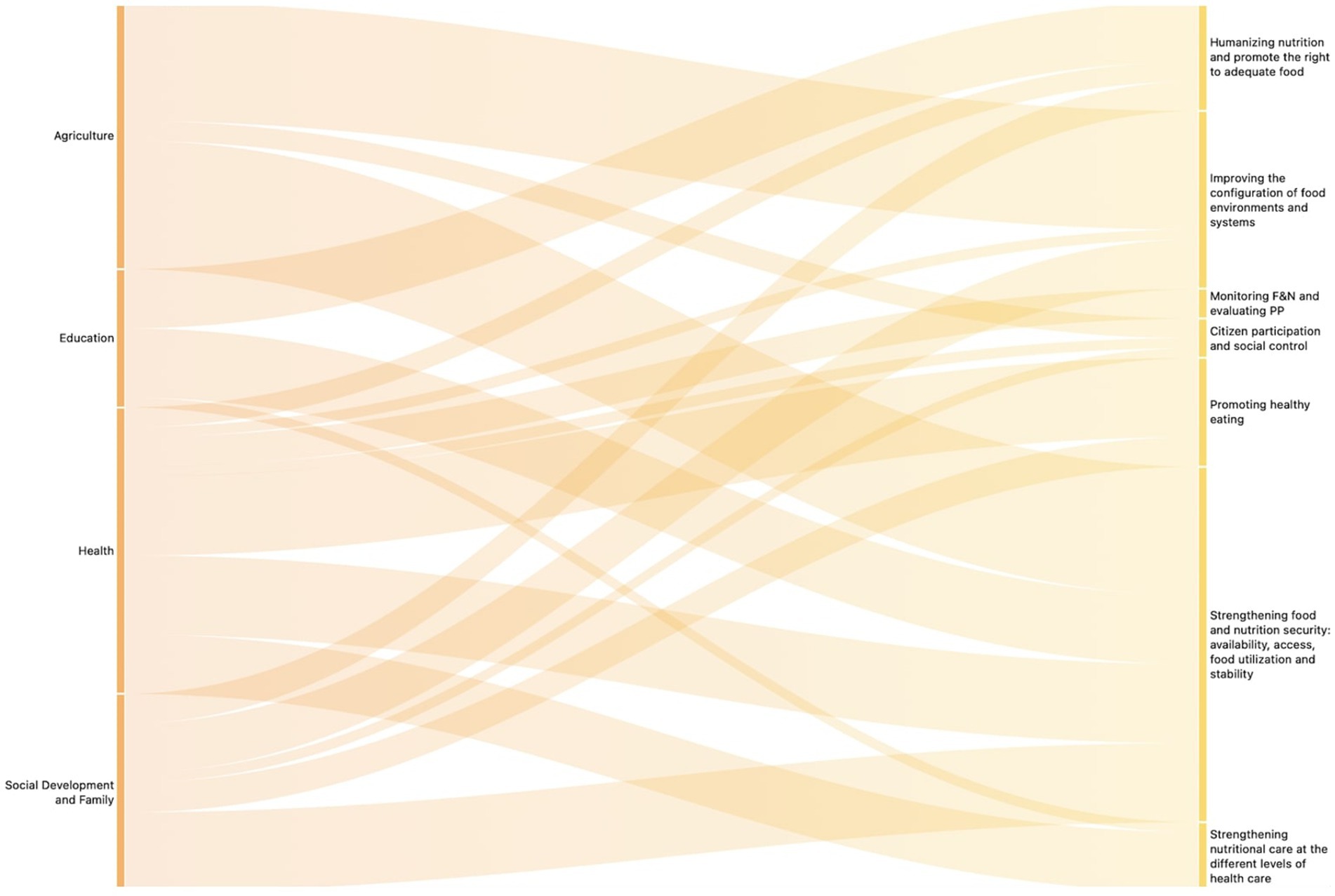
Figure 6. Co-occurrence scheme between RPPO and NFNP components. Components “Monitoring food and nutrition and evaluating public policies” and “Promoting citizen participation and social control” have been condensed to “Monitoring F&N and evaluating PP” and “Citizen participation and social control” respectively to accommodate the space limitations of the Sankey diagram.
4 Discussion
In this study, a total of n = 245 programs were identified, of which 70 had references to FNS dimensions in their objectives, evenly distributed between RPPO and APPO, with an allocated budget of $10,804.5 kMM for 2021. This represents only 0.042% of the national budget, indicating a modest investment in food security. Literature demonstrates a clear correlation between the allocation of national budget resources to food security programs and improved food security outcomes. However, the way resources are spent, however, is directly related to an improved access to healthy food and resilience to food crises (Thow et al., 2018), sustainable agriculture promotion and monitoring and evaluation (Candel and Biesbroek, 2018), nutritional education (Candel, 2014), and reducing significantly instances of hunger, malnutrition, and overall food insecurity (Milani-Bonab et al., 2023).
The results also indicate a prioritization of overall food security programs within the Social Development and Family sector, closely followed by Agriculture. Conversely, the Health, Women and Gender Equality, and Education sectors showed less emphasis, presenting a scope for enhanced integration. This distribution is critical for the efficacy of national food security strategies, and the literature suggests that uncoordinated efforts may lead to fragmented and inefficient initiatives. Thow et al. (2018) and Milani-Bonab et al. (2023) highlight the risks of isolated operations, including policy incoherence and coverage gaps that fail to address complex food security challenges. Candel (2014) further identifies the detrimental effects of dispersed accountability on program evaluation and impact. To mitigate these issues, experts recommend the establishment of formal mechanisms, such as inter-ministerial committees and policy coherence, to ensure aligned objectives and consolidate efforts across different governmental sectors involved in food security. In this sense, public policies could redirect more financial resources toward food security programs, especially in those critical aspects identified as deficient in coverage or effectiveness.
Related to the content analysis, the results showed that ministries prioritize different aspects of food security according to their specific roles. The Education and Agriculture ministries seem to focus more on the supply side (“Availability” and “Access”), while the Health ministry also gives weight to the “Utilization” aspect, which can relate to nutrition. The Social Development and Family ministry appears to address food security in a more holistic manner. Prioritizing certain dimensions of food security, like availability or access, over others can result in a fragmented policy landscape that fails to address the root causes of food insecurity in a comprehensive manner (Thow et al., 2018). Such an imbalanced focus may inadvertently exacerbate inequities, disproportionately affecting vulnerable groups and perpetuating cycles of food insecurity (Candel and Biesbroek, 2018). For example, if policies and strategies only focus on increasing food production without addressing issues of access, distribution, and utilization, vulnerable groups may continue to face barriers in accessing nutritious and affordable food. At the same time, a lack of attention to the social, economic, and environmental dimensions of food security can perpetuate cycles of food insecurity by failing to address the root causes of vulnerability and inequity. Additionally, a narrow approach can undermine the resilience of food systems, making them less capable of resisting various shocks and stresses; whereas, a holistic strategy that considers all dimensions—including stability and agency—promotes sustainable outcomes (Candel and Biesbroek, 2018). In this sense, Moragues-Faus et al. (2017) indicate that to achieve sustainable food security, strategies should foster empowerment, support varied agricultural practices, bolster local markets, and enhance community resilience, ensuring inclusivity and adaptability to future shocks. For instance, greater collaboration between the Ministries of Education and Agriculture could be encouraged to jointly address aspects of food availability and access, while the Ministry of Health could lead inter-ministerial initiatives focused on food utilization and nutrition.
Results also showed that inter-ministerial integration was partial, with some programs addressing multiple dimensions of food security, but there was a general lack of cohesion and coordination among ministries, limiting the effectiveness of the food security response. Coordination is essential in unifying government departments like agriculture, trade, health, and environment to enhance policy coherence for the multi-dimensional challenges of food security. As Moragues-Faus et al. (2017) note, synchronized strategies improve resource allocation, reduce redundancy, and form comprehensive policies that cover production to nutrition and sustainability. Policy integration mechanisms, as advocated by Thow et al. (2018), and capacity building, suggested by Candel and Biesbroek (2018), reinforce inter-ministerial cooperation. Robust monitoring and evaluation frameworks are also critical, assessing impacts and refining policies based on evidence, as pointed out by Moragues-Faus et al. (2017). Same authors indicate that including a diverse set of stakeholders, from non-governmental to community actors, enriches strategies and promotes sustainable food security initiatives.
In the coherence analysis, although all ministries showed programs related to the “Strengthening food security and nutrition” component, the lack of alignment with the “Deepening intersectorality and health in all policies” component indicates a missed opportunity to more comprehensively integrate health into food security policies. To enhance the efficacy of national food and nutrition policies, study findings suggests strategies that bridge the gap from policy formulation to execution. Multi-stakeholder partnerships are essential, as detailed by Milani-Bonab et al. (2023), promoting inclusive policymaking through diversified stakeholder engagement. The Processual Policy Integration Framework proposed by the same authors encourages understanding the interconnections between policy dimensions—frames, subsystems, goals, and instruments—to foster aligned implementation. Thow et al. (2018) further advocate for an extensive policy content analysis, scrutinizing policy across sectors to resolve inconsistencies and better meet actual needs. However, implementing these policies faces challenges, notably resource constraints, such as limited political commitment, human capital, and institutional capabilities, which impede the effective application of public nutrition policies. Debie et al. (2022) emphasize the importance of adequately and equitably distributing financial resources within health systems to address disparities in access to health services and promote health equity. For instance, Universal Health Coverage of Japan ensures coherent health policies to achieve better access for its population (OECD, 2016). Similarly, the “Health in All Policies” framework in Finland, Sweden, and Norway focuses on coherent health policies and budget allocation to address these challenges (WHO, 2014). The engagement of civil society is also crucial; their exclusion poses a barrier to nutrition policy action, thus affecting health promotion program success (Thow et al., 2018). Lastly, regional differences in social, economic, and political contexts significantly shape the design and implementation of nutrition policies, creating disparities in health program outcomes (Milani-Bonab et al., 2023). The identification of this gap indicates an opportunity to review and modify existing programs, as well as to design new initiatives that integrate health more effectively into food security policies.
Future research in the field of FNS could address several key areas to enhance understanding and effectiveness of these initiatives. One approach could involve evaluating the accuracy and quality of public information regarding the goals and budget allocations of the food security public programs, including a comparative analysis between stated objectives and actual program implementation. Another important line of research could be the exploration of operational and logistical challenges faced by the food security public programs, possibly through case studies or analysis of barriers to achieving program objectives (Brownhill and Hickey, 2012). Additionally, investigating how contextual variations affect the implementation and effectiveness of programs (Di Prima et al., 2022) within the RPPO could offer valuable insights, considering socioeconomic, cultural, and political factors. Expanding the scope to include other governmental bodies and civil society organizations in the analysis could provide an intersectoral or multisectoral perspective on collaboration for food security (Caviedes et al., 2023). Finally, employing broader interdisciplinary approaches and advanced mixed methods, such as geospatial analysis (Hossain et al., 2020; Swati and Kavita, 2021) or qualitative methods (del Valle M et al., 2023) to capture the experiences of program beneficiarie, which could significantly enrich the understanding of food security programs.
Finally, while this study employs a mixed methodology involving both qualitative content analysis and quantitative assessment, there are certain limitations to consider. In the first, the analysis relies on publicly available information regarding FNS objectives and budget allocations, which depends on how clear the available information is and its quality. Any potential discrepancies between publicly stated objectives and actual program implementation are not addressed in this analysis. Moreover, the study does not deepen into the difficulties of program execution, focusing primarily on objective alignment. In addition, the assessment of NFNP components within the RPPO is based on the information available in the stated objectives of the programs, and any further contextual variations are not explored. The scope of the study is also confined to the identified ministries and does not include other relevant government bodies, such as other ministries and public services and/or societal organizations that might contribute to food security efforts.
5 Conclusion
This study aimed to assess the inter-ministerial integration and coherence of ministerial food governance in Chile in relation to the Social Determinants of Health (SDH) and the objectives and components of the National Food and Nutrition Policy (NFNP). Through a mixed-methodology approach, we analyzed food security programs in selected Chilean ministries using content, financial, and program reviews to assess their alignment and integration with the NFNP objectives. Findings reveal a modest investment in food security, accounting for only 0.042% of the national budget, highlighting a significant opportunity to increase resources dedicated to this crucial area. Although various ministries address aspects of food security, a lack of cohesion and coordination among ministries limits the effectiveness of the response to food insecurity.
A key conclusion that emerges from this study is the insufficient inter-ministerial coordination. While some ministries prioritize specific dimensions of food security according to their institutional roles, a clear gap in alignment with critical components of the NFNP, particularly concerning the deepening of “intersectorality and the integration of health in all policies,” is evident. This lack of coordination raises several critical questions: Are the existing programs in Chile, and the agencies and ministries responsible for them, forming a cohesive strategy? If not, why is this the case? What steps should be taken to improve this situation? These questions highlight the necessity for a more integrated approach and a strategic framework that aligns the efforts of various stakeholders.
The absence of inter-ministerial coordination translates into a fragmented and less effective strategy for addressing food insecurity and related issues such as obesity, which has a severe impact on healthcare costs. According to the Organization for Economic Co-operation and Development (OECD, 2019), obesity-related healthcare costs in Chile accounted for around 2.4% of total healthcare spending in 2016. Moreover, projections indicate that reducing obesity rates by 20% by 2030 could potentially decrease obesity-related healthcare spending by about 7% by that year. These findings underscore the importance of addressing these questions to bridge the gap between ministries and foster intersectoral collaboration to address obesity as a critical component of the NFNP, ultimately leading to more effective public health outcomes.
Finally, the practical and theoretical implications of this study are many. They underscore the urgent need for increased investment in food security and the importance of robust mechanisms for inter-ministerial integration. The identification of gaps in alignment with the NFNP suggests opportunities for reviewing existing programs and developing new initiatives that more effectively integrate health considerations into food security policies. This study also points to future research directions, including the assessment of the accuracy and quality of public information on food security programs, the exploration of challenges in program execution, and the consideration of contextual variations in policy implementation. Expanding the scope to include other government bodies and civil society organizations could offer richer and more holistic perspectives on food security in Chile.
Data availability statement
The original contributions presented in the study are included in the article/Supplementary material, further inquiries can be directed to the corresponding author.
Author contributions
MV: Conceptualization, Formal analysis, Investigation, Methodology, Visualization, Writing – original draft, Writing – review & editing. KS: Supervision, Writing – review & editing. SB: Methodology, Supervision, Writing – review & editing.
Funding
The author(s) declare that financial support was received for the research, authorship, and/or publication of this article. This research was made possible thanks to the Ministry of Education (ANID, previous CONICYT) from the Chilean government under the Becas Chile scholarship program and to the Global Academy of Agriculture and Food Systems at The University of Edinburgh.
Acknowledgments
The authors would like to extend their gratitude to Dr. Fiona Borthwick, Dr. Geraldine McNeil, and Dr. Alan Duncan from the Global Academy of Agriculture and Food Systems at the University of Edinburgh, as well as Professor Liz Grant from the Usher Institute, University of Edinburgh.
Conflict of interest
The authors declare that the research was conducted in the absence of any commercial or financial relationships that could be construed as a potential conflict of interest.
Generative AI statement
The authors declare that Generative AI was used in the creation of this manuscript. In the preparation of this article, ChatGPT (version GPT-4, OpenAI) was used solely for English rephrasing purposes, specifically to ensure clarity and coherence in language. All conceptual and analytical content remains the author’s original work.
Publisher’s note
All claims expressed in this article are solely those of the authors and do not necessarily represent those of their affiliated organizations, or those of the publisher, the editors and the reviewers. Any product that may be evaluated in this article, or claim that may be made by its manufacturer, is not guaranteed or endorsed by the publisher.
Supplementary material
The Supplementary material for this article can be found online at: https://www.frontiersin.org/articles/10.3389/fsufs.2024.1431969/full#supplementary-material
References
Banco Central de Chile. (2021). Indicadores diarios 2021- Dólar observado. Available at: https://si3.bcentral.cl/Indicadoressiete/secure/Serie.aspx?gcode=PRE_TCO¶m=RABmAFYAWQB3AGYAaQBuAEkALQAzADUAbgBNAGgAaAAkADUAVwBQAC4AbQBYADAARwBOAGUAYwBjACMAQQBaAHAARgBhAGcAUABTAGUAdwA1ADQAMQA0AE0AawBLAF8AdQBDACQASABzAG0AXwA2AHQAawBvAFcAZwBKAEwAegBzAF8AbgBMAHIAYgBDAC4ARQA3AFUAVwB4AFIAWQBhAEEAOABkAHkAZwAxAEEARAA%3d. Accessed in May 28, 2024.
BIPS – Banco Integrado de Programas Sociales. (2021). Available at: https://programassociales.ministeriodesarrollosocial.gob.cl/. Accessed in May 3, 2021.
Brooks, J. (2014). Policy coherence and food security: the effects of OECD countries’ agricultural policies. Food Policy 44, 88–94. doi: 10.1016/j.foodpol.2013.10.006
Brownhill, L., and Hickey, G. M. (2012). Using interview triads to understand the barriers to effective food security policy in Kenya: a case study application. Food Secur. 4, 369–380. doi: 10.1007/s12571-012-0183-2
Candel, J. J. (2014). Food security governance: a systematic literature review. Food Secur. 6, 585–601. doi: 10.1007/s12571-014-0364-2
Candel, J. J. L. (2019). The expediency of policy integration. Policy Stud. 42, 346–361. doi: 10.1080/01442872.2019.1634191
Candel, J. J., and Biesbroek, R. (2016). Toward a processual understanding of policy integration. Policy. Sci. 49, 211–231. doi: 10.1007/s11077-016-9248-y
Candel, J. J., and Biesbroek, R. (2018). Policy integration in the EU governance of global food security. Food Secur. 10, 195–209. doi: 10.1007/s12571-017-0752-5
Caviedes, J., Ibarra, J. T., Calvet-Mir, L., and Junqueira, A. B. (2023). “Listen to us”: small-scale farmers’ understandings of social-ecological changes and their drivers in important agricultural heritage systems. Reg. Environ. Chang. 23:158. doi: 10.1007/s10113-023-02145-9
Chappell, M. J. (2018). Beginning to end hunger. In Beginning to End Hunger. University of California Press.
Chinseu, E., Stringer, L., and Dougill, A. (2018). Policy integration and coherence for conservation agriculture initiatives in Malawi. Sustain. Agri. Res. 7, 51–62. doi: 10.5539/sar.v7n4p51
Clapp, J., Moseley, W. G., Burlingame, B., and Termine, P. (2022). The case for a six-dimensional food security framework. Food Policy 106:102164. doi: 10.1016/j.foodpol.2021.102164
Debie, A., Khatri, R. B., and Assefa, Y. (2022). Successes and challenges of health systems governance towards universal health coverage and global health security: a narrative review and synthesis of the literature. Health Res. Policy Syst. 20:50. doi: 10.1186/s12961-022-00858-7
Del Castillo Hermosa, J., Planas Serralta, L., and Boza Martínez, S. (2021). “Evaluación sectorial “Política de Promoción de Exportaciones”” in División de Control de Gestión Pública, Dirección de Presupuestos – (DIPRES, Ministerio de Hacienda).
del Valle M, M., Hernández, R., Boden, L., and Riveros, J. L. (2023). Redefining food sources: exploring the disconnect between goat farming and its perceived sustainability—a case study in Chitima, Mozambique. Sustain. For. 15:11071. doi: 10.3390/su151411071
del Valle M, M., Shields, K., Alvarado Vázquez Mellado, A. S., and Boza, S. (2022). Food governance for better access to sustainable diets: a review. Front. Sustain. Food Syst. 6:784264. doi: 10.3389/fsufs.2022.784264
DIPRES – Dirección de Presupuestos de Chile. (2021). Evaluación sectorial “Política de Promoción de Exportaciones”. División de Control de Gestión Pública, Dirección de Presupuestos, Santiago, Chile.
Di Prima, S., Wright, E. P., Sharma, I. K., Syurina, E., and Broerse, J. E. (2022). Implementation and scale-up of nutrition-sensitive agriculture in low-and middle-income countries: a systematic review of what works, what doesn’t work and why. Glob. Food Sec. 32:100595. doi: 10.1016/j.gfs.2021.100595
Duncan, J., and Claeys, P. (2018). Politicizing food security governance through participation: opportunities and opposition. Food Secur. 10, 1411–1424. doi: 10.1007/s12571-018-0852-x
EVS-Elige Vivir Sano (2020). Radiografía de la obesidad infantil. Available at: http://eligevivirsano.gob.cl/wp-content/uploads/2020/01/PPT-EVS-15012020-Final.pdf Accessed on May 03 2021.
FAO, UNICEF, WFP, WHO (2020). The state of food security and nutrition in the world 2020. Rome, FAO: Transforming food systems for affordable healthy diets.
Fernández, A., Martínez, R., Carrasco, I., and Palma, A. (2017). Impacto Social y Econo ́mico de la Malnutricio ́n: Modelo de Ana ́lisis y Estudio Piloto en Chile, el Ecuador y México [Social and Economic Impact of Malnutrition: Analysis Model and Pilot Study in Chile, Ecuador and Mexico], at 86, 102, U.N. Doc. LC/TS.2017/32.
Hawkes, C. (2007). Promoting healthy diets and tackling obesity and diet-related chronic diseases: what are the agricultural policy levers? Food Nutr. Bull. 28, S312–S322. doi: 10.1177/15648265070282S210
Hawkes, C., and Popkin, B. M. (2015). Can the sustainable development goals reduce the burden of nutrition-related non-communicable diseases without truly addressing major food system reforms? BMC Med. 13, 1–3. doi: 10.1186/s12916-015-0383-7
Hawkes, C., Ruel, M. T., Salm, L., Sinclair, B., and Branca, F. (2020). Double-duty actions: seizing programme and policy opportunities to address malnutrition in all its forms. Lancet 395, 142–155. doi: 10.1016/S0140-6736(19)32506-1
Hossain, M. J., Das, S., Chandra, H., and Islam, M. A. (2020). Disaggregate level estimates and spatial mapping of food insecurity in Bangladesh by linking survey and census data. PLoS One 15:e0230906. doi: 10.1371/journal.pone.0230906
Kushitor, S. B., Drimie, S., Davids, R., Delport, C., Hawkes, C., Mabhaudhi, T., et al. (2022). The complex challenge of governing food systems: the case of south African food policy. Food Secur. 14, 883–896. doi: 10.1007/s12571-022-01258-z
Milani-Bonab, A., Kalantari, N., Takian, A., and Haghighian-Roudsari, A. (2023). Food and agriculture, nutrition and health related policy integration in Iran’s national development agenda and their alignment with the sustainable development goals. Environ. Dev. Sustain. 25, 3353–3378. doi: 10.1007/s10668-022-02171-3
Monticone, F., Barling, D., Parsons, K., and Samoggia, A. (2023). Identifying food policy coherence in Italian regional policies: the case of Emilia-Romagna. Food Policy 119:102519. doi: 10.1016/j.foodpol.2023.102519
Moragues-Faus, A., Sonnino, R., and Marsden, T. (2017). Exploring European food system vulnerabilities: towards integrated food security governance. Environ. Sci. Pol. 75, 184–215. doi: 10.1016/j.envsci.2017.05.015
National Food and Nutrition Policy. (2017). Ministry of Health, Government of Chile. Available at: http://www.bibliotecaminsal.cl/wp/wp-content/uploads/2018/01/BVS_POL%C3%8DTICA-DE-ALIMENTACI%C3%93N-Y-NUTRICI%C3%93N.pdf. Accessed on 08 February 2021.
National Health Survey. (2017). First Results. Ministry of Health, Government of Chile. Available at: https://www.minsal.cl/wp-content/uploads/2017/11/ENS-2016-17_PRIMEROS-RESULTADOS.pdf (Accessed October 19, 2020).
National Socioeconomic Characterization Survey. Ministry of Social Development and Family, Government of Chile. Food Insecurity Outcomes. (2022). Available at: https://datasocial.ministeriodesarrollosocial.gob.cl/fichaIndicador/814/1 (accessed on 03 May 2024).
OECD (2016). Universal Health Coverage and Health Outcomes. Available at: https://www.oecd.org/els/health-systems/Universal-Health-Coverage-and-Health-Outcomes-OECD-G7-Health-Ministerial-2016.pdf. Accessed on June 3, 2024.
Shrimpton, R., and Rokx, C. (2012). The double burden of malnutrition: A review of global evidence. Washington (DC): The World Bank.
Sibbing, L., Candel, J., and Termeer, K. (2021). A comparative assessment of local municipal food policy integration in the Netherlands. Int. Plan. Stud. 26, 56–69. doi: 10.1080/13563475.2019.1674642
Swati, R., and Kavita, A. (2021). Measuring and mapping the state of food insecurity in Rajasthan, India. Geograp. Environ. Sustain. 14, 33–40. doi: 10.24057/2071-9388-2020-67
Thow, A. M., Greenberg, S., Hara, M., Friel, S., duToit, A., and Sanders, D. (2018). Improving policy coherence for food security and nutrition in South Africa: a qualitative policy analysis. Food Secur. 10, 1105–1130. doi: 10.1007/s12571-018-0813-4
Vio del Río, F. The nutrition transition in Chile. Food policy for developing countries: the role of government in the global food system. (2007). Edited by Per Pinstrup-Andersen and Fuzhi Cheng, Case study of the program food policy for developing countries: The role of government in the global food system. Cornell University.
WHO. (2013). Determinantes sociales de la salud. Available at: http://www.who.int/social_determinants/es/. Accessed on March 3, 2021.
WHO. (2021). Obesity and overweight. Available at: https://www.who.int/news-room/fact-sheets/detail/obesity-and-overweight#:~:text=39%20million%20children%20under%20the,Obesity%20is%20preventable. Accessed on June 6, 2022.
Keywords: Chile, coherence, food security, governance, integration, public programs
Citation: del Valle M M, Shields K and Boza S (2024) Integration and coherence in food governance—a comprehensive analysis of food security public programs in Chile. Front. Sustain. Food Syst. 8:1431969. doi: 10.3389/fsufs.2024.1431969
Edited by:
José Antonio Teixeira, University of Minho, PortugalReviewed by:
Stuart W. Bunting, Independent researcher, Sudbury, United KingdomWenjin Long, China Agricultural University, China
Viswanathan Pozhamkandath Karthiayani, Amrita Vishwa Vidyapeetham (Amritapuri Campus), India
Copyright © 2024 del Valle M, Shields and Boza. This is an open-access article distributed under the terms of the Creative Commons Attribution License (CC BY). The use, distribution or reproduction in other forums is permitted, provided the original author(s) and the copyright owner(s) are credited and that the original publication in this journal is cited, in accordance with accepted academic practice. No use, distribution or reproduction is permitted which does not comply with these terms.
*Correspondence: Martín del Valle M, bWFydGluLmRlbHZhbGxlQGVkLmFjLnVr
 Martín del Valle M
Martín del Valle M Kirsteen Shields1
Kirsteen Shields1 Sofia Boza
Sofia Boza